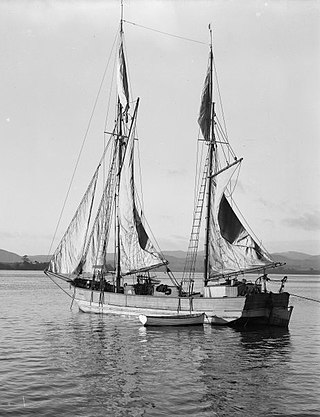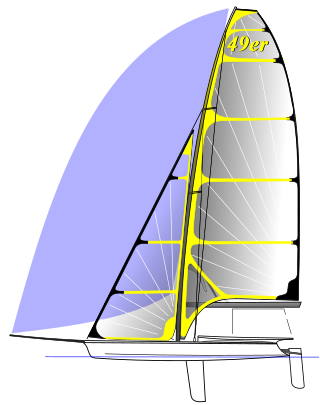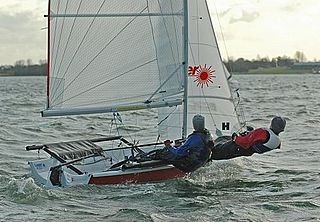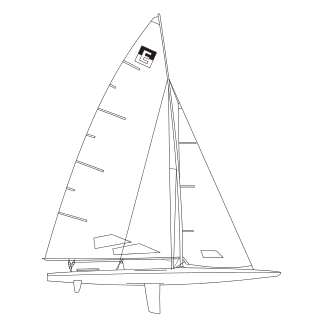
Dinghy sailing is the activity of sailing small boats by using five essential controls:

A scow is a smaller type of barge. Some scows are rigged as sailing scows. In the 19th and early 20th centuries, scows carried cargo in coastal waters and inland waterways, having an advantage for navigating shallow water or small harbours. Scows were in common use in the American Great Lakes and other parts of the U.S., Canada, southern England, and New Zealand. In modern times their main purpose is for recreation and racing.

Dinghy racing is a competitive sport using dinghies, which are small boats which may be rowboats, have an outboard motor, or be sailing dinghies. Dinghy racing has affected aspects of the modern sailing dinghy, including hull design, sail materials and sailplan, and techniques such as planing and trapezing.

The Laser is a class of single-handed, one-design sailing dinghies using a common hull design with three interchangeable rigs of different sail areas, appropriate to a given combination of wind strength and crew weight. Bruce Kirby designed the Laser in 1970 with an emphasis on simplicity and performance.

Planing is the mode of operation for a waterborne craft in which its weight is predominantly supported by hydrodynamic lift, rather than hydrostatic lift (buoyancy).

The 49er and 49er FX is a two-handed skiff-type high-performance sailing dinghy. The two crew work on different roles with the helm making many tactical decisions, as well as steering, and the crew doing most of the sail control. Both of the crew are equipped with their own trapeze and sailing is done while cantilevered over the water to the fullest extent to balance against the sails.

The International 505 is a One-Design high-performance two-person monohull planing sailing dinghy, with spinnaker, utilising a trapeze for the crew.
A skiff is any of a variety of essentially unrelated styles of small boats. Traditionally, these are coastal craft or river craft used for leisure, as a utility craft, and for fishing, and have a one-person or small crew. Sailing skiffs have developed into high performance competitive classes. Many of today's skiff classes are based in Australia and New Zealand in the form of 12 ft (3.66 m), 13 ft (3.96 m), 16 ft (4.88 m) and 18 ft (5.49 m) skiffs. The 29er, 49er, SKUD and Musto Skiff are all considered to have developed from the skiff concept, all of which are sailed internationally.

The Fireball is a British sailing dinghy that was designed by Peter Milne as a one-design racer and first built in 1962.

The Laser 4000(now "4000") is a racing dinghy designed by Phil Morrison crewed by two persons. Its one-design weight-equalised system enables physically differing sailors to compete on a level playing field. It is most popular in Europe, particularly the UK, France and Italy.

The 18 ft Skiff is considered the fastest class of sailing skiffs. The class has a long history beginning with races on Sydney Harbour, Australia in 1892 and later in New Zealand. The boat has changed significantly since the early days, bringing in new technology as it became available. Because of the need of strength, agility and skill, the class is considered to be the top level of small boat sailing. Worldwide this boat is called the "18 Foot Skiff". It is the fastest conventional non-foiling monohull on the yardstick rating, with a score of 675, coming only third after the Tornado and Inter 20.

The International 14 is a British racing sailboat, crewed by two sailors. The class was established in 1928.

The E Scow is an American sailing dinghy that was designed by Arnold Meyer Sr as a one-design racer and first built in 1924.

The 12 ft Skiff is a development dinghy class dating back to the early 20th century. It is sailed in Australia and New Zealand. It is 12 ft (3.7 m) in length, hence the name, and is a two-man boat. Both the crew and the helm are able to use the trapeze at the same time. It has an asymmetrical spinnaker and a jib, in addition to the mainsail.

The Cherub is a 12 feet long, high performance, two-person, planing dinghy first designed in 1951 in New Zealand by John Spencer. The class is a development class, allowing for significant variation in design between different boats within the rule framework. The minimum hull weight was originally 110 lbs.

A sailing hydrofoil, hydrofoil sailboat, or hydrosail is a sailboat with wing-like foils mounted under the hull. As the craft increases its speed the hydrofoils lift the hull up and out of the water, greatly reducing wetted area, resulting in decreased drag and increased speed. A sailing hydrofoil can achieve speeds exceeding double and in some cases triple the wind speed.

The NS14 is an Australian restricted development class of sailing dinghy. Measuring 14 feet in length, the class was designed the 1960 and introduced at the Northbridge sailing club in Sydney, Australia, with control of the class transferred to the NS14 Association of New South Wales in 1965. Subsequently the boat was introduced to the other states, prior to being taken to New Zealand in 1995 and the United States in 1998.
The Butterfly is a one-design sailing dinghy, originally designed for a crew of two, but now most commonly raced single-handed. It was designed in 1961 in Libertyville, Illinois by John Barnett. The 12-foot (3.7 m) hull is a scow design. The craft has a stayed 18-foot (5.5 m) mast set as a Marconi rig with a single mainsail with a 75-square-foot (7.0 m2) surface area. The cockpit is 15 ½" deep, exceptionally deep for this size of sailboat, and can accommodate an adult up to 6 feet in height.
The RS600FF is a modification of the RS600, light-weight sailing dinghy designed by Clive Everest and Nick Peters. It differs from the conventional RS600 as it has hydrofoils.

The Waszp is an Australian, single-handed, hydrofoiling sailboat that was designed by Andrew McDougall as a one-design racer for youth and adults, and first built in 2016.

















